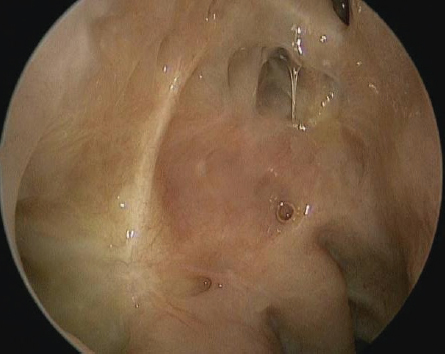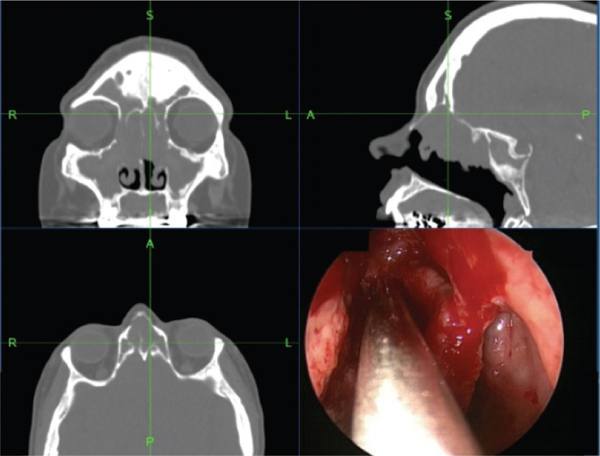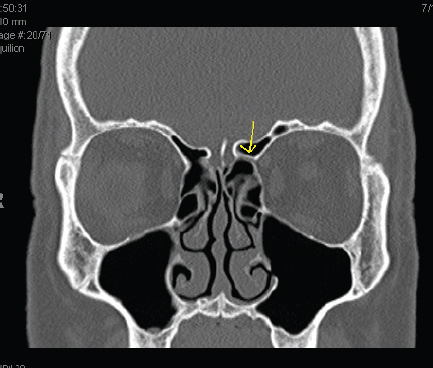19 Complications in Revision Sinus Surgery Endoscopic sinus surgery has become increasingly popular and is the standard manner of surgical treatment of sinus disease that is not responsive to medical therapy. Since its inception three decades ago, many technological developments have broadened the surgical scope of the endoscopic approach and have led to better outcomes and less morbidity. Despite the medical and surgical advances, endoscopic sinus surgery is not without risks. The close proximity of sinuses to the orbit, brain, and carotid artery makes sinus surgery one of the most dangerous surgeries within our field. Revision surgery can be even more perilous because many helpful landmarks are not present and heavy scarring and osteitis can increase the difficulty of the surgery (Fig. 19.1). Image guidance is particularly helpful in these cases because it can help evaluate the sinus anatomy and recognize altered anatomy that may be problematic during surgery (Fig. 19.2). Complications do occur and can be disastrous, resulting in litigation. The endoscopic surgeon must not only be experienced in these techniques, but also have knowledge of the anatomy to help avoid complications. This chapter will provide a closer look at the major complications and provide pearls on how to prevent and manage them. There are many types of complications that can occur with endoscopic sinus surgery. They are classified as minor and major complications.1,2 Minor complications include hyposmia, adhesions, headache, dental/facial pain, epistaxis not requiring blood transfusion, and periorbital ecchymosis or emphysema. Major complications are much more serious and result in more devastating effects. They include orbital hematoma, ocular muscle injury, blindness, carotid injury, and skull base penetrations resulting in cerebrospinal fluid (CSF) leak, meningitis, and/or pneumocephalus. The orbit comprises seven bones; the thinnest bone is a portion of the ethmoid bone called the lamina papyracea. This eggshell thick bone forms the lateral border of the ethmoid sinus cavity. Close attention should be paid to this area both preoperatively on computed tomography (CT) scans and intraoperatively for the possibility of bony dehiscence and prolapsed orbital contents into the nasal cavity. Although rare (<1%), orbital complications during sinus surgery do occur.2–4 They include enophthalmos, emphysema, orbital hematoma, extraocular muscle injury, and optic nerve damage. Figure 19.1 Right nasal cavity with excessive scarring and absent middle turbinate. Orbital hematoma is the most common orbital complication during endoscopic sinus surgery.2–4 Hematomas can occur when there is damage to the periorbita, orbital fat, and vascular supply to the orbital contents. While there are two types of bleeding that lead to orbital hematomas, immediate and delayed onset, their mechanisms of action are different.5 Delayed onset hematomas are a result of damage to the orbital veins that lie within the orbital fat and along the lamina papyracea. This low-pressure bleeding results in a gradual accumulation of blood within the orbital cone. While generally considered less catastrophic, this type of bleeding can also result in an increase of intraocular pressure and result in retinal ischemia and blindness. In contrast with the delayed type, the immediate type is a result of arterial bleeding. When injured, the vessels often retract within the orbit causing rapid accumulation of blood within the tightly spaced orbit. The anterior and/or posterior ethmoidal arteries are usually the culprits. Both arteries are branches of the internal carotid system and ophthalmic arteries. The anterior ethmoid artery runs from a lateral to a medial direction along the skull base just posterior to the frontal recess. While it is usually encased in bone and runs directly along the skull base, it has been shown to be dehiscent and hang below the skull base, making it an easy target during surgery.5,6 The posterior ethmoid artery is usually more protected. It is encased by bone and runs along the skull base just superior to the sphenoid sinus. Depending on the severity of the sinus disease and extent of nasal polyps, it can be difficult for the surgeon to identify the arteries during surgical dissection. The first step in prevention is preoperative planning. Preoperative endoscopic examination can not only determine the pathology but can also reveal any altered anatomy in revision cases. Fine CT scans with coronal reconstruction are optimal to study the orbital anatomy. The anterior ethmoidal artery exiting the orbit can be identified by locating the anterior ethmoidal artery peak or “nipple” (Fig. 19.3).7 This is usually located just along the skull base at the confluence of the superior oblique and medial rectus muscles. Any dehiscence or thinning of the lamina papyracea should be noted, especially in a revision surgery. Another important step is to prepare the patient intraoperatively before beginning the surgery. The eyes should be in the field and taped along the lateral canthal region to allow constant examination and palpation during the surgery. Frequent inspection for periocular bruising and palpation for increased intraocular pressure should be performed during sinus surgery. If orbital bruising, firmness on palpation, and proptosis is discovered, the surgeon must be concerned for a developing hematoma. Several actions must be preformed simultaneously to prevent a disastrous outcome. The retina is very sensitive to ischemia and blindness has been shown to occur within 90 minutes of hematoma onset.5,7 The first step is to obtain an intraoperative ophthalmology consult. While awaiting their arrival, the nasal cavity needs to be inspected for bleeding. Any nasal packing should be removed and hemostasis should be achieved. Intraocular pressures should be evaluated with a tonometer and the source of the bleeding (arterial vs. venous) should be determined. Venous bleeding usually results in a slower build up of hematoma and intraocular pressure. As a result, conservative measures such as intravenous mannitol, steroids, and orbital massage can be given to help lower intraocular pressures. However, close observation should be performed because these methods may fail to lower intraocular pressure. When these fail, surgical intervention should be performed to prevent blindness. Figure 19.3 Coronal computed tomography scan demonstrating path of anterior ethmoid artery (arrow). Ocular dysmotility and diplopia result from orbital muscle injury. While the medial rectus is the most commonly injured, the superior oblique and inferior rectus can also be injured.3,8,9
Classification
Orbital Hematoma
Orbital Muscle Injury
![]()
Stay updated, free articles. Join our Telegram channel

Full access? Get Clinical Tree





